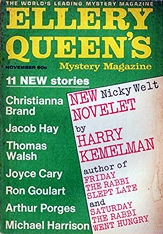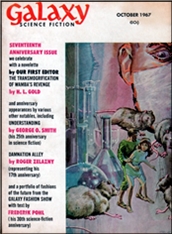Fri 15 Aug 2025
Diary Review: ELLERY QUEEN’S MYSTERY MAGAZINE November 1967.
Posted by Steve under Diary Reviews , Magazines[8] Comments
ELLERY QUEEN’S MYSTERY MAGAZINE. November 1967. Overall rating: ***
HARRY KEMELMAN “Man on a Ladder.” Novelette. Professor Nicky Welt solves the murder of a scholar [committed to academic work.] I may be in the minority, but I found this story wordy and flat, and if I may, stagey, The chess analogy is good, but isn’t it clear? (2)

JACOB HAY “The Belkamp Apparatus.” A sales representative for a Grand Rapids firm is mistaken for a master spy. It is humorous. (4)
COLIN WATSON “The Infallible Clock.” If a wife disappears and a large clock stops working, what would you suspect? (2)
WILLIAM BRITTAIN “Mr. Strang Finds the Answers,” The key to Mr. Strang’s chemistry exam is stolen, but the mystery is outweighed by the human factors involved. (4)
RICHARD CURTIS “Odds Bodkins and the £1000 Wager.” The odds on breaking out of prison? Only in England. (3)
G. R. SPENCER “The Polite Mrs. Payne.” First story. A holdup man’s politeness is his downfall. (3)
JOYCE CARY “The Sheep.” Published earlier in Texas Quarterly Winter 1958. Tomlin is a sheep, helpless to speak out for himself; excellent characterization that collapses into nothingness. (3)
RON GOULART “Rink.” Parody. 1001st Precinct mystery. Funny. (3)
ELLERY QUEEN “Uncle from Australia.” First appeared in The Diners Club Magazine, June 1965. The Cockney aitch strikes again. Easy puzzle. (2)
THOMAS WALSH “Poor Little Rich Kid.” First appeared in Collier’s, 18 April 1936, as “The Boy on the Train.” A boy with an inheritance, and a weak father, befriends a couple of rodeo cowboys. Good story, but over-plotted. (3)
JAMES CROSS “The Man Who Called Himself James Cross.” Sebastian Nonesuch. A sequel to “The hkzmp gsv bzmp Case,” published in the November 1966 issue of EQMM (reviewed here). The revealed details of the exploits of US agent Sebastian Nonesuch must be stopped. Often hilarious. (4)
MICHAEL HARRISON “The Fires in the Rue St. Honore.” Another “unpublished” story of C. Auguste Dupin. It seems to be better than the rest, but it turns out to be hopeless for the attentive reader. (2)
ARTHUR PORGES “The Nose of a Beagle.”That the detective is Charles Darwin is obvious from the title. (2)
CHRISTIANNA BRAND “Here Lies…” How to drown a wife who is a swimming champion, and how to build an atmosphere of suspense most effectively. (5)






